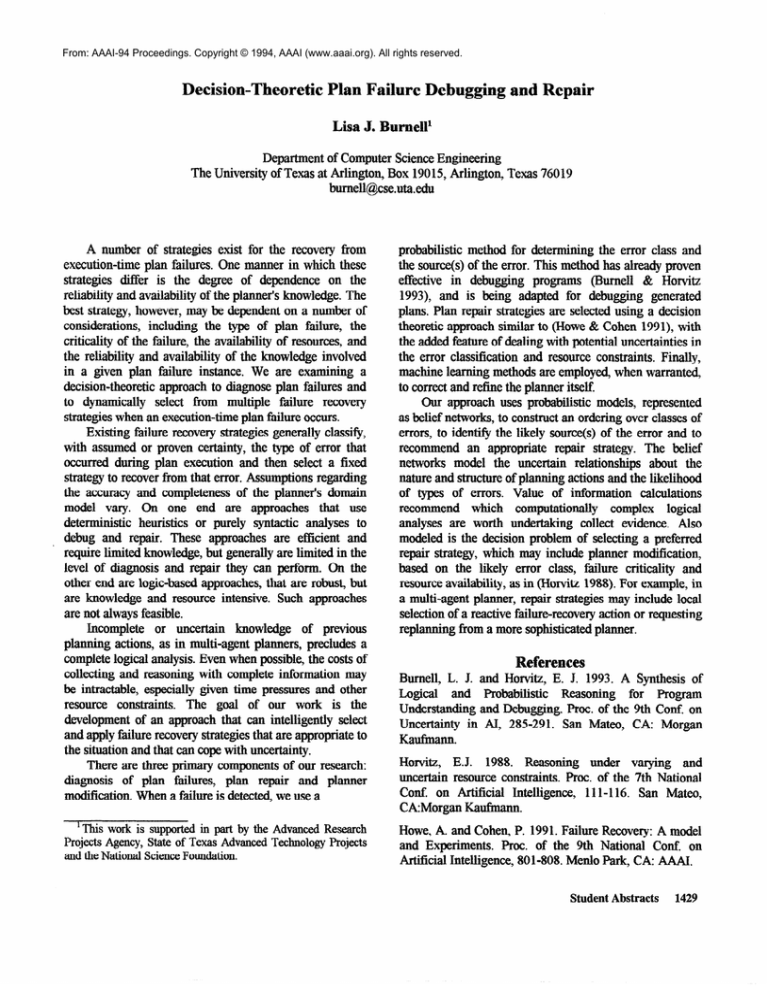
From: AAAI-94 Proceedings. Copyright © 1994, AAAI (www.aaai.org). All rights reserved.
Decision-Theoretic
Plan Failure Debugging and Repair
Lisa J. Burnell’
Department of Computer Science Engineering
The University of Texas at Arlington, Box 190 15, Arlington, Texas 760 19
burnell@cse.uta.edu
A number of strategies exist for the recovery from
execution-time plan failures. One manner in which these
strategies difFer is the degree of dependence on the
reliability and availability of the planner’s knowledge. The
best strategy, however, may be dependent on a number of
considerations, including the type of plan failure, the
criticality of the failure, the availability of resources, and
the reliability and availability of the knowledge involved
in a given plan failure instance. We are examining a
decision-theoretic approach to diagnose plan fakes and
to dynamically select fkom multiple failure recovery
strategies when an execution-time plan failure occurs.
Existing failure recovery strategies generally classify,
with assumed or proven certainty, the type of error that
occurred during plan execution and then select a fixed
strategy to recover from that error. Assumptions regarding
the accuracy and completeness of the planner’s domain
model vary. On one end are approaches that use
deterministic heuristics or purely syntactic analyses to
debug and repair. These approaches are efficient and
require limited knowledge, but generally are limited in the
level of diagnosis and repair they can perform. On the
other end are logic-based approaches, that are robust, but
are knowledge and resource intensive. Such approaches
are not always feasible.
Incomplete or uncertain knowledge of previous
planning actions, as in multi-agent planners, prechrdes a
complete logical analysis. Even when possible, the costs of
collecting and reasoning with complete information may
be intractable, especially given time pressures and other
resource constraints. The goal of our work is the
development of an approach that can intelligently select
and apply ftilure recovery strategies that are appropriate to
the situation and that can cope with uncertainty.
There are three primary components of our research:
diagnosis of plan failures, plan repair and planner
modification. When a failure is detected, we use a
probabilistic method for determining the error class and
the source(s) of the error. This method has already proven
effective in debugging programs (Burnell 4% Horvitz
1993), and is being adapted for debugging generated
plans. Plan repair strategies are selected using a decision
theoretic approach similar to (Howe & Cohen 1991), with
the added feature of dealing with potential uncertainties in
the error classification and resource constraints. Finally,
machine learning methods are employed, when warranted,
to correct and refine the planner itself.
Our approach uses probabilistic models, represented
as belief networks, to construct an ordering over classes of
errors, to identify the likely source(s) of the error and to
recommeud an appropriate repair strategy. The belief
networks model the uncertain relationships about the
nature and structure of planning actions and the likelihood
of types of errors. Value of information calculations
recommend which computationally complex logical
analyses are worth undertaking collect evidence. Also
modeled is the decision problem of selecting a preferred
repair strategy, which may include planner modification,
based on the likely error class, kihue criticality and
resource availability, as in (Horvitz 1988). For example, in
a multi-agent planner, repair strategies may include local
selection of a reactive failure-recovery action or requesting
replanning from a more sophisticated planner.
‘This work is supported in part by the Advanced Research
Projects Agency, State of Texas Advanced Technology Projects
and the National Science Foundation.
Howe, A. and Cohen, P. 1991. Failure Recovery: A model
and Experiments. Proc. of the 9th National Conf. on
Artificial Intelligence, 80 l-808. Menlo Park, CA: AAAI.
Fences
Burnell, L. J. and Horvitz, E. J. 1993. A Synthesis of
Logical and Probabilistic Reasoning for Program
Understanding and Debugging Proc. of the 9th Conf. on
Uncertainty in AI, 285-291. San Mateo, CA: Morgan
Kaufknann.
Horvitz, E.J. 1988. Reasoning under varying and
uncertain resource constraints. Proc. of the 7th National
Conf. on Artificial Intelligence, 11 l-l 16. San Mateo,
CA:Morgan Kaufinann.
Student Abstracts
1429





